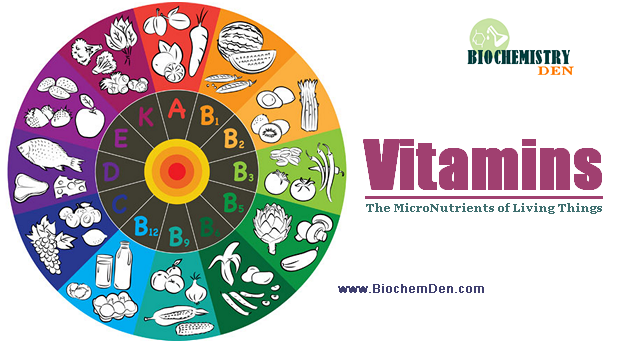While water-soluble vitamins like vitamin C and the B vitamins need to be continually supplied in the diet because excess is excreted by the body, fat soluble Vitamins can be stored in the body’s fat reserves and liver when intake exceeds the body’s needs. This means fat soluble Vitamins can build up to potentially toxic levels if too much is consumed.
Water-soluble vitamins are easily dissolved in water and transported in bodily fluids. In contrast, fat soluble Vitamins rely on lipids for absorption and transport. Dietary fat is required for efficient absorption of fat soluble Vitamins.
What is Fat Soluble Vitamins?
fat soluble Vitamins are a group of vitamins that are soluble in dietary fat and are stored in the body’s fatty tissues. There are four fat soluble Vitamins:
- Vitamin A (Retinol): Vitamin A plays a crucial role in maintaining healthy vision, skin, and the immune system. It is also important for proper growth and development.
- Vitamin D (Calciferol): Vitamin D is essential for the absorption of calcium and phosphate in the intestines, which is necessary for maintaining healthy bones and teeth. It is often called the “sunshine vitamin” because the body can produce it when exposed to sunlight.
- Vitamin E (Tocopherol): Vitamin E acts as an antioxidant, protecting cells from damage caused by free radicals. It also plays a role in immune function and skin health.
- Vitamin K (Phylloquinone): Vitamin K is necessary for blood clotting and bone health. It helps in the synthesis of clotting factors in the liver and supports the proper mineralization of bones.
Unlike water-soluble vitamins (such as vitamin C and the B vitamins), which are not stored in the body and are excreted in the urine when consumed in excess, fat soluble Vitamins can be stored in the liver and fatty tissues.
This means that excessive intake of fat soluble Vitamins over an extended period can lead to toxicity, as they can accumulate in the body. It’s important to maintain a balanced diet and not overconsume fat soluble Vitamins to avoid adverse health effects.
Types of fat soluble Vitamins
There are four main types of fat soluble Vitamins:
A. Vitamin A (Retinoids)
Vitamin A is a group of compounds called retinoids. The most common and active form of vitamin A in the body is retinol. Other forms of vitamin A include retinal, retinoic acid, and provitamin A carotenoids like beta-carotene.
Vitamin A includes a group of related compounds known as retinoids. The most active form of Vitamin A is retinol. Its chemical structure consists of a cyclic hydrocarbon tail with a polar group containing a beta-ionone ring.
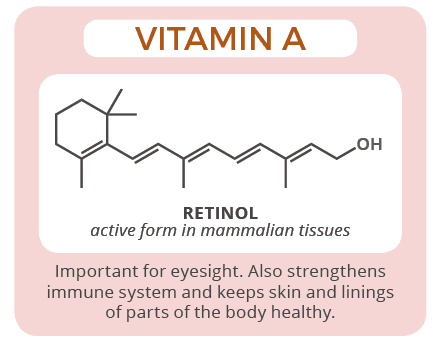
1. Sources of vitamin A
- Preformed vitamin A – Found in animal sources like liver, fish oils, dairy products, and egg yolks.
- Pro-vitamin A carotenoids – Found in plant sources like carrots, sweet potatoes, spinach, cantaloupe, red peppers, mangoes, and apricots. Beta-carotene is converted to retinol in the body.
2. Functions and roles in the body
Vitamin A has several important functions:
- Plays a critical role in vision and eye health
- Supports cell growth and differentiation
- Involved in immune function
- Needed for red blood cell production
- Maintains skin and mucous membrane health
3. Deficiency symptoms
Vitamin A deficiency can lead to:
- Night blindness
- Dry eyes (Xerophthalmia)
- Compromised immune function
- Anemia
- Skin disorders
4. Recommended dietary intake
The recommended dietary allowance (RDA) for vitamin A is:
- 900 mcg RAE for adult males
- 700 mcg RAE for adult females
RAE stands for Retinol Activity Equivalents – a measurement that accounts for different forms of dietary vitamin A.
Pregnant women have increased vitamin A needs at 770 mcg RAE.
Retinol and its derivatives play a crucial role in vision, cell differentiation, immune function, and maintaining healthy skin and mucous membranes.
Suggested for more details: Vitamin A: Structure and Functions
B. Vitamin D (Calciferol)
Vitamin D refers to a group of fat soluble Vitamins including D2 (ergocalciferol) and D3 (cholecalciferol). Vitamin D3 is the form naturally synthesized in the skin during sun exposure.
Vitamin D exists in several forms, with Vitamin D2 (ergocalciferol) and Vitamin D3 (cholecalciferol) being the most important. Both have a similar structure with a steroid-like backbone.
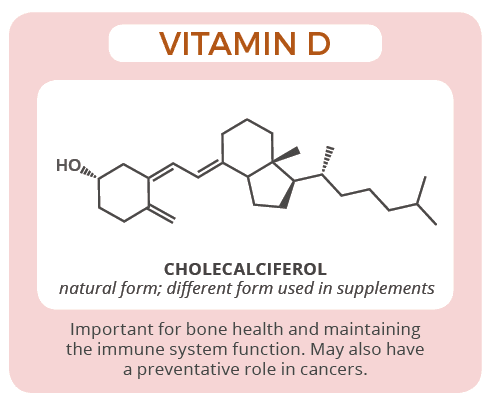
1. Sources of vitamin D
- Sunlight – Vitamin D3 is synthesized in the skin during UVB radiation exposure.
- Food sources – Vitamin D is found naturally in fatty fish, fish oils, egg yolks, and fortified foods like milk, yogurt, orange juice and cereal.
- Supplements – Vitamin D2 and D3 supplements can help meet needs.
2. Functions and roles in the body
- Facilitates calcium absorption for bone mineralization
- Supports immune function
- Neuromuscular function
- Modulates cell growth
3. Importance for bone health
Vitamin D promotes calcium absorption in the intestines. It enables proper mineralization of bone tissue. Without adequate vitamin D, bones can become thin, brittle, or misshapen. This can lead to rickets in children and osteomalacia or osteoporosis in adults.
4. Synthesis in the skin
When skin is directly exposed to UVB radiation from sunlight, it synthesizes cholecalciferol (vitamin D3). Melanin pigments in the skin reduce vitamin D synthesis. Sunscreen, clothing, darker skin tones, and aging also limit vitamin D production.
5. Deficiency symptoms
- Rickets (children)
- Osteomalacia (adults)
- Osteoporosis
- Muscle weakness
- Increased risk of respiratory infections
The RDA for vitamin D is:
- 600 IU (15 mcg) up to age 70
- 800 IU (20 mcg) over age 70
Some groups like pregnant women may need higher intakes. Vitamin D is better absorbed when taken with fatty foods.
Vitamin D is essential for calcium and phosphorus absorption in the intestine, thus maintaining bone health. It also plays a role in immune function.
C. Vitamin E (Tocopherol)
Vitamin E refers to a group of compounds called tocopherols and tocotrienols. Alpha-tocopherol is the most active form in humans.
Vitamin E comprises a group of compounds called tocopherols and tocotrienols. The most biologically active form is alpha-tocopherol. The structure includes a chromanol ring and a hydrophobic side chain.
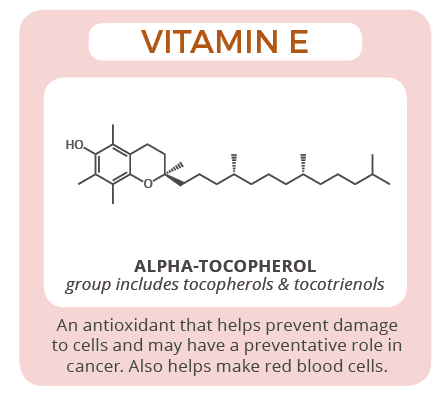
1. Sources of vitamin E
- Plant oils – soybean, sunflower, corn, olive, canola
- Nuts and seeds – almonds, sunflower seeds, hazelnuts
- Green leafy vegetables
- Fortified cereals and spreads
2. Functions and roles in the body
- Powerful antioxidant that protects cell membranes
- Supports immune function
- Plays a role in DNA repair
- Inhibits blood clotting when in excess
3. Antioxidant properties
The antioxidant activity of vitamin E protects cell membranes from damage caused by reactive oxygen species and free radicals. This helps reduce oxidative stress in tissues.
Vitamin E may also regenerate or spare other antioxidants like vitamin C.
4. Deficiency symptoms
Severe vitamin E deficiency is rare but can impair nerve conduction, weaken the immune system, and cause hemolytic anemia in infants.
The RDA for vitamin E is 15 mg per day for adults. Intakes over 1,000 mg may have detrimental effects.
Vitamin E acts as a powerful antioxidant, protecting cell membranes from oxidative damage. It also contributes to immune function and skin health.
D. Vitamin K (Phylloquinone and Menaquinone)
Vitamin K is a group of fat soluble Vitamins including phylloquinone (vitamin K1) found in plants and menaquinones (vitamin K2) from animal and fermented foods.
Vitamin K encompasses several compounds, with phylloquinone (Vitamin K1) and menaquinone (Vitamin K2) being the primary forms. They share a common structure with a naphthoquinone ring.
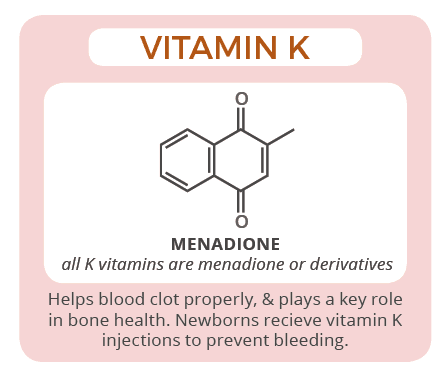
1. Sources of vitamin K
- K1 sources: Leafy green vegetables like kale, spinach, broccoli, Brussels sprouts, cabbage
- K2 sources: Meat, dairy, eggs and fermented foods like natto, cheese, sauerkraut
2. Functions and roles in the body
- Essential for proper blood clotting
- Supports bone mineralization and density
- May protect arteries from calcification
3. Blood clotting and bone health
Vitamin K activates proteins involved in blood coagulation and bone metabolism. Deficiency impairs the blood’s ability to clot and weakens bones.
4. Deficiency symptoms
Deficiency is very rare but can cause:
- Excessive bleeding from cuts or wounds
- Easy bruising
- Breaks in weakened bones
The RDA for vitamin K is 90 mcg/day for women and 120 mcg/day for men. Vitamin K deficiency is rare but can occur in babies or with long-term antibiotic use.
Vitamin K is essential for blood clotting, as it is involved in the synthesis of clotting factors in the liver. It also plays a role in bone health and may have cardiovascular benefits.
These fat-soluble vitamins differ in their chemical structures and functions, but they all play vital roles in various physiological processes within the body. Proper dietary intake of these vitamins is essential for overall health and well-being.
Absorption and Transport
A. Importance of dietary fat for absorption
fat soluble Vitamins require fat for absorption in the small intestine. Bile salts emulsify and break down fat, creating tiny droplets that enable vitamin absorption.
Without adequate fat intake (at least 5-10g per meal), the absorption of fat soluble Vitamins is impaired.
B. Role of bile in absorption
Bile acids secreted from the gallbladder emulsify dietary fats, breaking them into microscopic micelles. This allows fat soluble Vitamins to be absorbed along with dietary lipids.
Impaired fat digestion or bile production can reduce vitamin absorption.
C. Transport in the bloodstream
Once absorbed into intestinal cells, fat soluble Vitamins are packaged into chylomicrons – lipoprotein particles that transport lipids through the lymphatic system and bloodstream.
Vitamins A, D, E and K circulate on chylomicrons to the liver for storage or to peripheral tissues to exert their effects and functions.
Storage and Excretion
A. How fat soluble Vitamins are stored in the body
Unlike water-soluble vitamins, fat soluble vitamins are readily stored in body tissues. When intake exceeds daily needs, excess vitamin A and D are stored in the liver while vitamins E and K accumulate in fatty tissues and membranes.
Stored vitamin A in the liver may provide reserves lasting up to 2 years in extreme deficiency. Vitamin D reserves may supply needs for 2-4 months without sun exposure or dietary intake.
B. Excretion processes
Since fat soluble vitamins dissolve in fat rather than water, they are not readily excreted in urine. Toxic levels can accumulate.
Vitamin A is degraded in the liver and excreted in feces and urine. Vitamins D, E, and K are excreted via feces and bile. Vitamin E is also excreted in breath and skin oils.
Health Implications
A. Benefits of fat soluble Vitamins
fat soluble Vitamins offer wide-ranging health benefits:
- Vitamin A – Essential for vision, immunity, growth and development
- Vitamin D – Critical for bone health and calcium metabolism
- Vitamin E – Protects cells from damage as an antioxidant
- Vitamin K – Enables blood clotting and healthy bones
B. Risks of excess fat-soluble vitamin intake
Since they are stored in the body, consuming too much of certain fat soluble Vitamins can cause toxicity:
- Vitamin A – Liver damage, bone loss, birth defects
- Vitamin D – Elevated calcium, kidney damage, arrhythmias
- Vitamin E – Increased bleeding risk, impaired immune function
C. Interactions with medications or other nutrients
fat soluble Vitamins can interact with certain medicines. Vitamin K can reduce the effectiveness of blood thinners. Vitamin E may increase bleeding risk when taken with anticoagulant or anti-platelet drugs.
Vitamins A and D may interact with cholesterol medications, diuretics, steroids, or bone drugs. High vitamin E intake can impair absorption of vitamins A and K.
Dietary Recommendations
A. Recommended Dietary Allowances (RDAs)
The Recommended Dietary Allowances (RDAs) set by the Food and Nutrition Board of the Institute of Medicine outline the average daily vitamin intakes needed to meet requirements for nearly all healthy individuals:
| Vitamin | RDA for Adult Males | RDA for Adult Females |
| Vitamin A | 900 mcg RAE | 700 mcg RAE |
| Vitamin D | 600-800 IU (15-20 mcg) | 600-800 IU (15-20 mcg) |
| Vitamin E | 15 mg (22.4 IU) | 15 mg (22.4 IU) |
| Vitamin K | 120 mcg | 90 mcg |
B. Tolerable Upper Intake Levels (ULs)
The Tolerable Upper Intake Levels (ULs) represent the maximum daily intakes unlikely to cause adverse effects:
- Vitamin A – 3,000 mcg RAE
- Vitamin D – 4,000 IU (100 mcg)
- Vitamin E – 1,000 mg (1,500 IU)
- Vitamin K – No established UL
Intakes above these levels may increase the risk of toxicity or other detrimental effects. Those with medical conditions should avoid excess supplementation without professional advice.
Dietary Sources
A. Foods rich in fat soluble Vitamins
Excellent dietary sources of fat soluble Vitamins include:
| Vitamin | Food Sources |
|---|---|
| Vitamin A | Beef or chicken liver, Sweet potato, Carrots, Spinach, Cantaloupe, Mango, Fortified milk and cereals |
| Vitamin D | Salmon, Sardines, Egg yolk, Fortified milk and juices, Beef liver, Mushrooms (with sun exposure) |
| Vitamin E | Almonds, Sunflower seeds, Hazelnuts, Wheat germ oil, Safflower oil, Spinach, Broccoli |
| Vitamin K | Kale, Spinach, Collard greens, Broccoli, Brussels sprouts, Fish, Liver, Fermented foods |
B. Dietary guidelines for meeting vitamin needs
The Dietary Guidelines for Americans recommend:
- Including good sources of each vitamin in meals and snacks
- Choosing healthy fats like olive or canola oil over saturated fats
- Limiting processed and fried foods low in vitamins
- Consuming a variety of fruits, vegetables, lean proteins, nuts and whole grains
Following a balanced, diverse diet should provide adequate fat soluble Vitamins for most healthy people without the need for supplementation.
Those with fat absorption issues or on restricted diets may benefit from a multivitamin containing fat soluble Vitamins.
Special Populations
A. Considerations for pregnant women
Pregnant women have increased needs for certain fat soluble Vitamins:
- Vitamin A – Require 770 mcg RAE to support fetal growth and development. Excess preformed vitamin A is teratogenic.
- Vitamin D – 600 IU (15 mcg) needed, higher doses may be recommended based on status. Important for fetal skeletal development.
- Vitamin K – Adequate intake is critical for proper fetal blood coagulation.
Prenatal vitamins containing safe levels of vitamins A, D, and K are recommended.
B. Vitamin supplements and medical conditions
Those with fat absorption disorders may require special forms or higher doses of fat-soluble vitamin supplements.
Conditions like liver disease, kidney failure, malabsorption, or obesity can affect storage, metabolism or absorption of these vitamins.
Individuals taking certain cholesterol or blood thinning medications should use caution with fat-soluble vitamin supplements due to potential interactions.
C. Age-related vitamin needs
Infants have very low vitamin stores at birth and breast milk alone may not provide sufficient vitamin D. Supplementation is often recommended, especially for exclusively breastfed babies.
Older adults tend to absorb and synthesize lower levels of vitamin D with less efficient kidney and liver function. Higher intakes through fortified foods, sunshine exposure and supplements helps compensate for age-related reductions in vitamin D status.
Risks and Benefits of Fat soluble Vitamins
Here are some of the risks and benefits of fat soluble Vitamins:
- Risks: fat soluble Vitamins can be stored in the body for long periods of time, and taking too much can lead to toxicity. Symptoms of toxicity can vary depending on the vitamin, but can include nausea, vomiting, headache, and even liver damage.
- Benefits: fat soluble Vitamins are essential for many important bodily functions. Getting enough fat soluble Vitamins can help to improve vision, bone health, immune function, and cell growth and repair.
How much fat soluble Vitamins do you need?
The recommended daily intake of fat soluble Vitamins varies depending on age, sex, and other factors. It is important to talk to your doctor to determine how much of each vitamin you need.
Most people can get enough fat soluble Vitamins from a healthy diet. However, some people may need to take supplements, such as pregnant women, older adults, and people with certain medical conditions.
Here are some tips for getting enough fat soluble Vitamins:
- Eat a variety of foods from all food groups, including fruits, vegetables, whole grains, lean protein, and healthy fats.
- Choose fortified foods, such as milk, cereal, and orange juice.
- Spend some time in the sun each day, or take a vitamin D supplement if you don’t get enough sun exposure.
- Talk to your doctor about whether you need to take a multivitamin or other supplements.
Facts about Fat Soluble Vitamins
fat soluble Vitamins are vitamins A, D, E, and K. They are absorbed in the small intestine with the help of bile, a digestive fluid produced by the liver. fat soluble Vitamins are stored in the body’s fat tissues and can be used over time. This is in contrast to water-soluble vitamins, which are excreted in the urine and need to be consumed on a daily basis.
Here are some facts about fat soluble Vitamins:
- Vitamin A is essential for vision, cell growth and repair, and immune function. Good sources of vitamin A include liver, egg yolks, dairy products, and orange and yellow fruits and vegetables.
- Vitamin D is important for bone health, immune function, and cell growth and repair. The body can produce vitamin D when exposed to sunlight, but it can also be obtained from food sources such as fatty fish, eggs, and fortified milk and cereals.
- Vitamin E is an antioxidant that protects cells from damage. Good sources of vitamin E include nuts, seeds, vegetable oils, and avocados.
- Vitamin K is necessary for blood clotting and bone health. Good sources of vitamin K include green leafy vegetables, broccoli, and Brussels sprouts.
Frequently Asked Questions
Why are fat soluble Vitamins only absorbed with fat?
fat soluble Vitamins are soluble in lipids, not water. They require fat for absorption because dietary fats stimulate the release of bile from the gallbladder, which emulsifies large fat droplets into tiny micelles that can transport fat soluble Vitamins through intestinal cell membranes. Without sufficient fat, absorption is drastically reduced.
Do fat soluble Vitamins get stored in the body?
Yes, unlike water-soluble vitamins, excess fat soluble Vitamins are readily stored. Vitamin A is stored primarily in the liver while vitamins D, E, and K accumulate in body fat and tissues. Stored vitamin A in the liver may supply reserves for over a year during deficiency, while vitamin D reserves may last 2-4 months without sun or dietary intake.
Can you take too much of fat soluble Vitamins?
Yes, consuming very high amounts of certain fat soluble Vitamins over a long period can lead to toxicity since they accumulate in tissues. High vitamin A intake can cause liver damage and bone loss, excess vitamin D leads to hypercalcemia, and too much vitamin E may increase bleeding risk. That’s why tolerable upper intake levels (ULs) have been established.
How can I make sure I get enough fat soluble Vitamins?
Eat a balanced diet with a variety of foods containing these vitamins like leafy greens, nuts and seeds, fatty fish, eggs, liver, fortified milk, and fresh produce like carrots, sweet potatoes and red peppers. Take a quality multivitamin to help fill any gaps if you have restricted food intake. Get sensible sun exposure for vitamin D and cook foods with healthy oils to aid absorption.
What foods contain vitamin K?
Excellent dietary sources of vitamin K include green leafy vegetables like kale, spinach, collards, broccoli, and Brussels sprouts. It is also found in meat, eggs, dairy products, and fermented foods such as natto, sauerkraut, and cheese. The best sources are vitamin K1 from leafy greens and vitamin K2 from meats, dairy, and fermented foods.
Is vitamin D only absorbed from sunlight?
No. While sunlight exposure enables vitamin D synthesis in the skin, you can also obtain it from certain foods. Fatty fish like salmon, mackerel, sardines and tuna contain substantial amounts. Smaller amounts are found in egg yolks, beef liver, cheese, and foods fortified with vitamin D like milk, yogurt, orange juice and cereals. However, sunlight accounts for over 90% of vitamin D in people with moderate exposure. Those with limited sun should consume good food sources or supplements.
Summary
So the fat soluble Vitamins play crucial roles in maintaining our overall health. These essential micronutrients, including vitamins A, D, E, and K, contribute to various bodily functions, from supporting our immune system to ensuring proper bone health.
While a balanced diet can usually provide these vitamins, some individuals may require supplements or fortified foods to meet their needs. Striking the right balance is essential, as both deficiencies and excessive intake can lead to health issues.
Ongoing research continues to reveal the intricate importance of fat soluble Vitamins in promoting human health and preventing diseases.
Discover more from Biochemistry Den
Subscribe to get the latest posts sent to your email.

